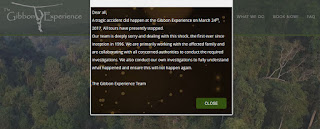By: Natalie Paris, The Telegraph (UK), March 28, 2017
A traveller has died ziplining at the Gibbon Experience forest camp in Laos.
The person, thought to be American, was at the remote attraction popular with backpackers travelling on a budget through South-East Asia. It boasts some of the world’s highest and longest ziplines, with the largest reaching 1,870ft across a forested valley in the north-west of the country, close to the border with Thailand.
The ziplines connect what the operating company claims are some the world’s tallest treehouses with some standing up to 131ft-high, level with the treeline. Guests stay in the treehouses and zipline in and out to access them.
Travellers hoping to book a stay with the gibbons were this week shocked to see a message on the Gibbon Experience website expressing regret over the tragedy, said to have taken place on March 24.
“Dear all,” it read, “A tragic accident did happen at the Gibbon Experience on March 24th, 2017. All tours have presently stopped. Our team is deeply sorry and dealing with this shock, the first ever since inception in 1996. We are primarily working with the affected family and are collaborating with all concerned authorities to conduct the required investigations. We also conduct our own investigations to fully understand what happened and ensure this will not happen again.”
The Gibbon Experience did not immediately respond to Telegraph Travel’s request for a comment and no details have been released as yet about the person who died.
Those ziplining attach harnesses themselves to the lines - preferably but not always while in the presence of guides - and keep one hand below the line and another over a piece of rubber above that will act as a brake if pulled down, causing friction to slow the rider down.
The website FAQs state that there have been three broken legs at the camp in the last ten years, with common accidents being twisted ankles during treks through the forest.
“A few people did not respect gliding rules and ended up bumping into each other fortunately with no serious consequences with th (sic) notable exception of a broken clavicule,” the website continues.
“There are inherent risks to any outdoor activities. However, this can be reduced by a cautious and risk-adverse attitude.”
It also states that the use of video cameras while ziplining can be dangerous and that “one-click” Go Pro-type equipment is prefered “as you will stay aware”.
Building began on the Gibbon Experience in Huay Xai in 1996. In 2008 it was designated as the Nam Kan National Park.
The project has always worked with the rural communities that live in the hills of the park and given money back to fund forest patrols, irrigation schemes and local schools, while also contributing to the wildlife in the forest.
While black gibbons are often heard, they are harder to spot, so shifting the experience away from the gibbons to the feeling of flying through the forest.
I visited the Gibbon Experience in 2008 and while I found it a thrilling, once-in-a-lifetime experience, I’ll admit I was slightly scared by the fact that it was down to me to clip myself on and off the lines and by rumours that I had heard about people getting their fingers caught at speed after putting a hand on the line.
A recent review of the Gibbon Experience posted on TripAdvisor in February 2017, claimed: "In our group of eight people (the small tree house group) we had 2 hand injuries, one bad enough to require a hospital visit. This was because the guides told us that a half kilometer long zip line was perfect for two people. Two groups crashed because there was only a small platform on the other side, and their combined body weight meant they were going incredibly fast. DO NOT DO TWO PEOPLE unless one is a guide."
Ziplining accidents are not uncommon.
In Thailand in 2015, a man and his female friend jumped off a platform racing down a 1,300ft-zipline in the popular tourist area of Chiang Mai before realising he wasn’t secured to the zip wire.

No comments:
Post a Comment